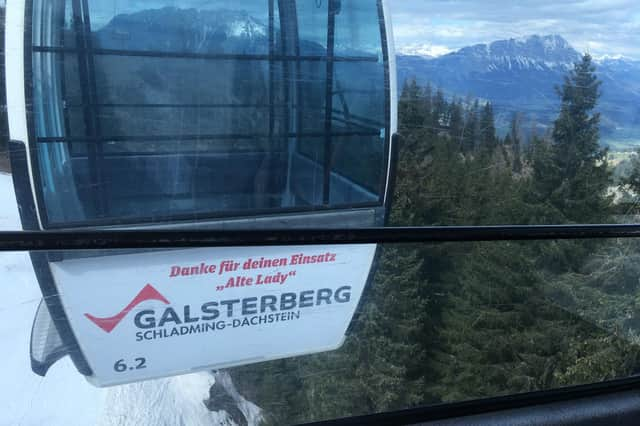Gondola gone: bidding farewell to the ‘old lady’ of Austrian ski lifts


A little over an hour's drive south and then east from Salzburg, Austria's Schladming-Dachstein ski region is home to eight different ski resorts, some of them famous, some of them not. The one most people have heard of is Planai, which sits directly above the town of Schladming and plays host to the annual Schladming Night Race – arguably the most dramatic stop in FIS Alpine Ski World Cup tour, with something akin to a football stadium atmosphere waiting for competitors as they come hurtling into the final section of the flood-lit course. Also very much on the international snowsports map is the Dachstein Glacier, which offers year-round on-piste skiing at 2,700m and also some fabled backcountry routes, most notably the sweaty-palms Edelgrieß run, which requires a precarious ladder climb up a forbidding cliff face and then a sketchy "no falling zone" traverse just to get to the start of the descent proper, which has pitches in excess of 50 degrees.
Elsewhere in this neck of the woods, however, there's mellower fun to be had. Situated above the little village of Pruggern, a few miles to the east of Schladming, the resort of Galsterberg may not have the glitz of Planai or the high-altitude drama of the Dachstein Glacier, but that's fine – its relative anonymity keeps the crowds down, to the extent that even in peak season it can still feel like a bit of a local secret. It mostly bills itself as a family-friendly resort: there's flood-lit sledging, a benign top-to-bottom blue run and even an Asterix-themed ski village for tots, where you can visit characters from the comic books in their ski-in, ski-out homes and throw snowballs at animatronic Romans. That said, there's also plenty of off-piste challenge to be found if you know where to look, including a surprising abundance of testing tree runs, while a schlep over to neighbouring peak of Pleschnitzzinken offers steep, satisfying, open-face powder turns without the if-you-fall-you-die pressure of the Edelgrieß.
Advertisement
Hide AdAdvertisement
Hide AdI've been lucky enough to snowboard all over Europe and North America over the last couple of decades, writing about bucket-list destinations like Whistler and Chamonix in these pages along the way, but I've almost certainly made more turns at Galsterberg than anywhere else, and as a result it's come to feel like a home from home. I know its moods, I know its secrets, I know that the greasy Tiroler-greustel is by far the best thing on the menu at the mid-station hütte, even though two in a row would almost certainly kill you. If I could only visit one ski hill for the rest of my life, this would be it.
The trouble with becoming too attached to a place, though, is that change can sometimes feel traumatic. A few years ago, when a prime section of tree skiing was cleared in order to widen one of the pistes, I felt bereft. And earlier this month, I felt another wave of nostalgia wash over me when I learned that the creaky old white gondolas I'd been riding up the hill for more than half my life were to be replaced, before the start of the 2022/23 season, with fancy new red ones. "Say goodbye to the 'old lady' on Easter Monday," read the posters in the toilets, ahead of the final day of the season, and the final journey of the old white cabins. It would have been impossible to refuse.
Rather tactlessly, I thought, one of the new red cabins was unveiled at the gondola base station on the 18th while the "old lady" was still faithfully working away, ferrying skiers up to the top of the hill. "In 6,5 Minuten am Berg" read the text painted onto the front of the new, almost-all-glass cabin, as if speed were everything. True, the old system had never been all that fast, but that was part of its charm. Most of the other resorts in the area offer easy, rapid access from the main road that runs through the bottom of the valley. At neighbouring Haus, for example, you pull directly into a giant car park, walk straight into the gondola base station and are instantly whisked uphill by a waiting cabin. At Galsterberg, by contrast, you have to drive up a dizzying series of switchbacks just to get to the bottom of the gondola – sometimes an adventure in itself in winter conditions – then wait patiently for one of only three pairs of cabins to arrive at the base station.
Once you finally get moving, the old lady isn't exactly slow, but she isn't exactly fast either, and she has to stop twice on the way up to allow people in other cabins to disembark. All that time swinging around in mid-air, though, is really just an opportunity to check out how much new snow has fallen, or to decide if a tantalising new line through the trees is going to be makeable or not.
Still, I suppose we should be talking about the old lady in the past tense now: by the start of next season those white cabins will be long gone, and skiers will be rocketing up to the new-look Bergstation in six-and-a-half minutes. Silly, I know, to get sentimental about a ski lift, but as the American writer James Wolcot once said, "everyone is entitled to his own nostalgia". Rest well old girl, and thanks for the memories.
